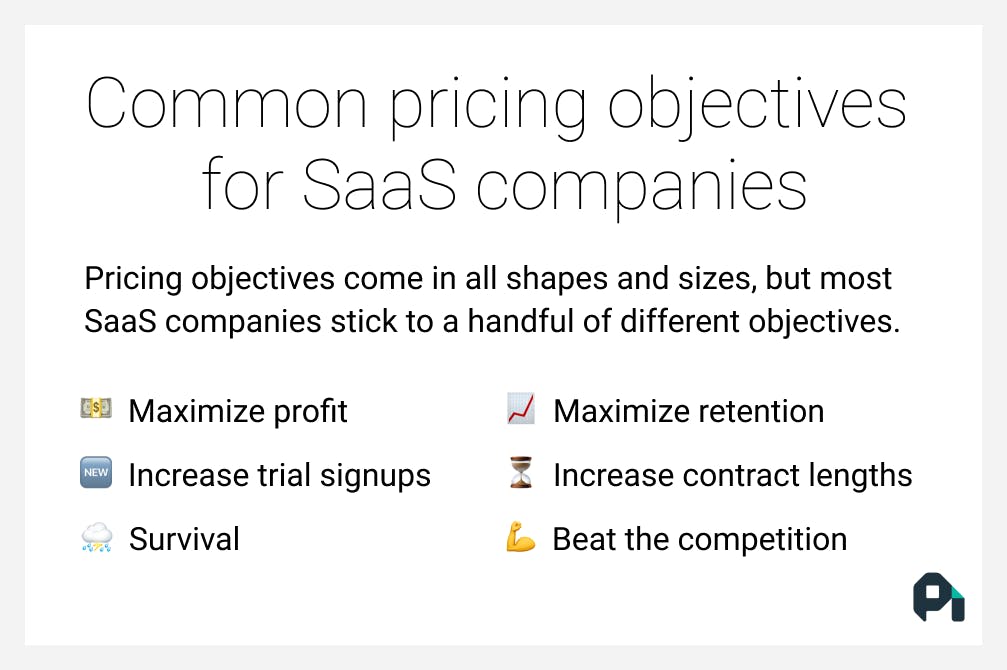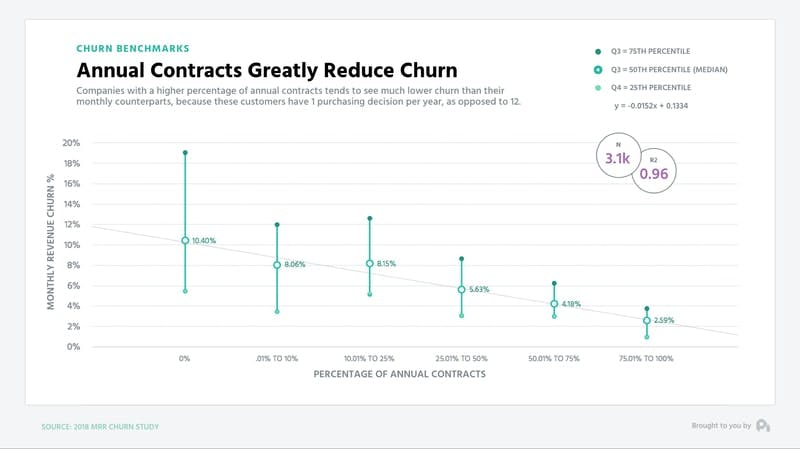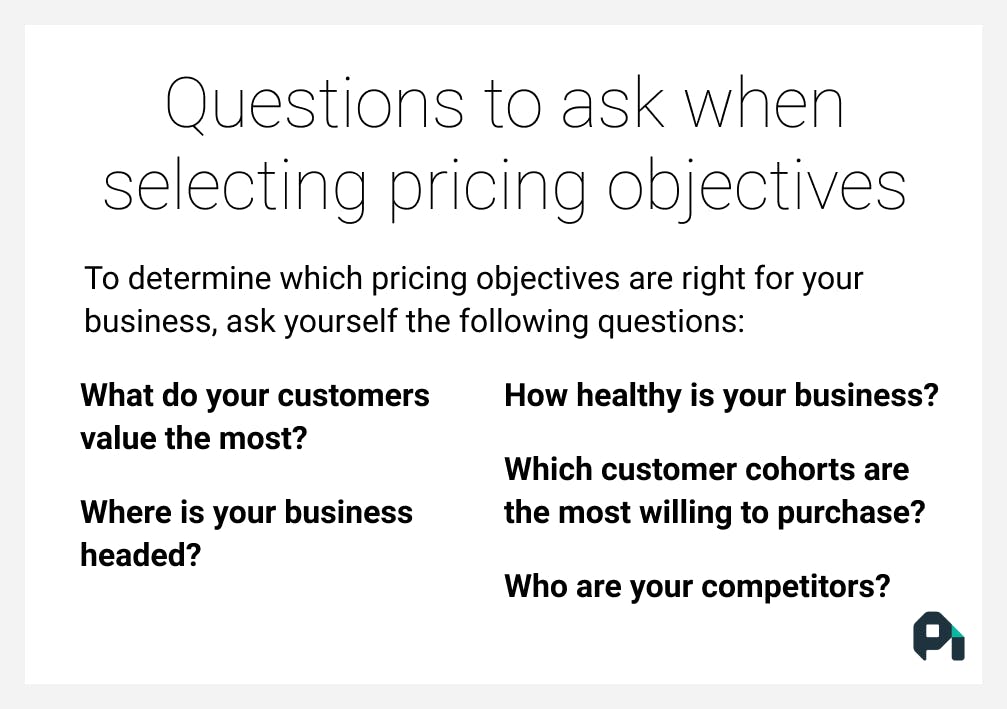Your pricing objective sets the course for your business’s pricing strategy and can mean the difference between the success and failure of your SaaS business. Here’s how to get started.
The price you choose affects more than just how much profit you’ll make or whether customers will pick your product over your competitor's. Yes, profit and market share are both valid pricing objectives, but they aren’t the only options, and they certainly aren’t always the best options.
Instead of thinking about pricing as a one-and-done process, your pricing should be another tool in your belt for reaching your business goals, whether that’s maximizing profit, boosting growth, or simply making ends meet. When setting prices, companies can (and should) have specific objectives in mind.
What are pricing objectives?
Pricing objectives are the goals that drive how your business sets prices for your product or service. These objectives can and should apply to pricing for both new and existing customers. The direction provided by pricing objectives is crucial to adjusting prices over time in order to meet your objectives.
Each pricing objective requires a different pricing strategy to meet business goals. Certain pricing methods work well for meeting a particular objective, while other combinations can contradict one another - it’s important to make sure your pricing objectives and strategies are closely matched.
Examples of pricing objectives
Turning a profit is obviously the most common pricing objective for every business—after all, you can’t run a sustainable business without making money. That said, there is more nuance to it and pricing objectives can go beyond pure profit. Here are some pricing objectives examples:
- Maximize short-term or long-term profit
- Maximize long-term sustainability
- Penetrate new markets
- Increase sales volume
- Steal market share from competitors
- Generate interest around new products
- Survive a slow period of business
Why prioritize pricing objectives?
Say you’re thinking about going on a vacation. If you’re like most people (that is, not entirely crazy), you wouldn’t just hop in your car and start driving or head to the airport and buy a ticket to the first random location you see listed on the departures board.
For most of us, vacations take planning. You’d first consider things like the kind of vacation you prefer. Would you rather spend time relaxing on the beach, or do you enjoy getting off the beaten path and exploring new places? Are you willing to spend lavishly on those experiences, or are you holding the purse strings tightly? Do you prefer hot or cold climates? How much vacation time do you have available?
There are dozens of factors that might factor into your decision. And while some people might enjoy the uncertainty of a loosely planned vacation, when it comes to your business, planning is essential. You need to consider what goals you’re trying to hit with your SaaS business before forming your pricing strategy.
You can't just pull a number out of your hat and call it a day. The optimum price point is the price where companies can best meet their objectives—but you first need to get clear on what those objectives are.
Your chosen pricing objective should guide your strategic pricing decisions—certain pricing strategies tend to work better or worse when seeking a specific pricing objective. For example, aiming to penetrate a new market might mean choosing prices that undercut your competitors, even though those prices might cut into your overall profits. Similarly, you might build interest in new products by offering them in a discounted bundle alongside existing products. Sometimes you don’t even have a choice—fighting to keep your business above water requires an entirely different pricing strategy.
Establishing your pricing objectives in advance makes choosing your pricing approach much more straightforward.
6 pricing objectives your SaaS business should consider
Pricing objectives come in all shapes and sizes, but most SaaS companies stick to a handful of different objectives, including revenue, adoption or retention, free trial signups, contract length, and competitors’ prices.

Let’s go through each in more detail, to help you understand which pricing objective is best for your SaaS business.
1. Maximize profit
Profit-oriented pricing objectives are defined to maximize the profit margin of each sale and the long-term profitability of the business. Put simply, profit-oriented pricing objectives are about making as much money as possible.
Most businesses take a twofold approach to profit maximization: they go for a price increase to juice their top-line revenue, and they reduce costs to increase their bottom-line profit. Both numbers play into each other to provide a superior return on investment—increasing pricing might lower the number of sales (without reducing revenue), which lowers per-account costs like support and hosting.
However, hitting numbers purely for the sake of hitting numbers does nothing unless you’re making a profit and retaining users. Getting the high-end buyers to buy your product may be a less profitable objective than having many middle-class buyers buy your product. You might find that you are spending more to acquire customers at the higher price point or that your churn rate increases after changing your prices.
2. Maximize retention
I’ve said before that retention is far more important for SaaS companies than acquisition, and your pricing can be designed to reflect that. Creating a retention-first pricing strategy can be a great objective for SaaS companies. Your prices should be set high enough that customers value your product and continue using it, but low enough that you’re not turning off your target customers with high sticker prices.
Putting retention first can be a great option for subscription companies, but you need to balance that against acquisition costs. Make sure that your CAC is low enough that you’re able to retain users at a profit and keep them from churning; the value you provide needs to be greater than the price so that they won’t churn.
3. Increase adoption and trial sign-ups
Another way you can optimize your pricing is for maximum trial sign-ups. Set your initial pricing low—or even offer a freemium option—to encourage more prospective customers to sign up for your platform. Then, monetize them later through upsells and expansion revenue.
Since the dollar cost of a free trial isn’t part of the equation, solving for trial subscriptions often means making decisions outside of the actual cost of your product. You can play with pricing elements such as free trial lengths, money-back guarantees, and free value-add services, like installation or configuration, to help maximize adoption.
Remember, though, while freemium is a great acquisition model, you shouldn’t make freemium your only pricing strategy.
4. Extend contract length
Another great pricing objective for subscription companies is to extend the lifecycle of their product line and maximize the length of customer contracts. Longer contracts correlate directly to greatly reduced churn while also keeping your acquisition costs in check.

The optimal contract length for SaaS startups varies, according to Tomasz Tunguz, but annual (or longer) contracts bring stability and predictability. They also give customer success teams more opportunity to create meaningful relationships with new customers and help them achieve their goals.
Ask yourself: Is your contract as long as it should be? Are you retaining users for a year and then letting them go or keeping them for a decade? Can lengthening your contract help minimize costs down the road?
5. Beat the competition
Yes, beating the competition might sound obvious, but your prices can be a powerful tool for maintaining or increasing your market share. Competitor objectives are not the most important thing to consider, but they have their relevance.
Pricing your product low can deter competition from entering a target market—some companies even choose to sell their products at a loss to prevent new players from entering a market. On the flip side, a high price can signal to potential customers that your product is of high quality, increasing the likelihood that they’ll choose your solution over those of your competitors.
6. Mix and match
Pricing objectives are like ice cream flavors: you don’t have to pick just one. In fact, mixing and matching multiple pricing objectives can be a great option for SaaS startups.
Say you want to maximize both adoption and revenue. Generally, you want a careful balance of the two to make the most revenue without losing market share. That “sweet spot” is your ideal price—it’s the inflection point where 50% of the people think it’s not too expensive, but 50% of the market thinks it’s not too cheap.
How to choose the best pricing objectives for your business
Your chosen pricing objectives can—and should—change over time as market conditions and your business change. What works today might not work in a year or two, so it’s important to understand how to choose the best pricing objectives for your business—and when to reassess.

What do your customers value?
Knowing what defines your product sets you up for having realistic pricing objectives. Your product—and what makes it valuable to your customers—should influence the pricing objectives you choose:
- Are you building a brand-new product or a luxury product, or are you a new competitor in a large market?
- Is your product defined as “the cheap alternative to XYZ” or “the best product in the business”?
Remember, your customers decide the value of your product. Higher-value products command higher prices and are generally more successful with profit-oriented pricing objectives. If your goal is to beat your competitors, pricing low is perfectly acceptable, but realize that getting into a price war affects the long-term sustainability of your company.
Which customer cohorts are more willing to purchase?
Every market and every customer persona is willing to pay a different amount for the value your product provides, and this needs to factored into your decision process when choosing a pricing objective.
Ask the following questions:
- How willing are customers to pay high versus low prices for the value you provide?
- Does that vary across different customer cohorts and personas?
- Which cohort is best to aim for with your product pricing?
You can create different pricing tiers with different price sensitivities that focus on different cohorts.
Where is your business headed?
Your pricing objectives depend heavily on your business’s goals for the future.
If you’re a startup looking for growth, you may have to be far more modest with your pricing objectives until you build an established customer base. On the other hand, if you’re running an industry-leading company, you can afford to be more bullish once you have time-tested methods for pricing new products.
Who are your competitors?
Knowing the other players in the market—what they charge, how much value they provide, and what advantages you offer over your rivals—is key to choosing the right pricing objectives.
Setting a lower price than your competitors might increase adoption with customers who shop on price alone, but are those really the kinds of customers you want? Likewise, setting a higher price gives customers the message that your product is higher quality and worth the additional cost, but will the higher cost outstrip customers’ willingness to pay?
How healthy is your business?
Sometimes, the pricing objective you choose is outside of your control.
Are you struggling to get by or raking in profits from lots of subscribers? If your business is healthy, you can look into pricing objectives around profitability or taking market share from competitors. But if you’re bootstrapping a startup and just scraping by, you’ll need to be very conservative and be in survival pricing mode.
Have your pricing reflect value
The truth is, you have a lot on your plate when it comes to subscription growth, but setting the right pricing objectives and pricing policies is one of a small handful of fundamentals you need to get right.
Pricing is one of the biggest factors that can help or hurt a business. Your pricing can be a strategic tool for reaching your objectives, or it can stifle your growth and lower your profitability.
It takes both a solid understanding of value and the data to back up your decisions to grow sustainably and reach your objectives. Luckily, we’ve got your back—our goal is to take care of everything else when it comes to subscription growth. We provide free reporting and analytics to help you set the right pricing objective for your business. Sign up for your free ProfitWell Metrics account today to get started.
Pricing Objectives FAQs
What are some of the most important examples of pricing objectives?
The most important pricing objective is to maximize the profitability of your business, either in the short or long-term (but preferably both). Your pricing should also take into account a desire to retain customers, increase the number of customers, extend the customer lifecycle, and beat out the competition.
What are some pricing objectives strategies?
Some common strategies for setting prices include competitive pricing (setting prices according to your competitors), market-based pricing (setting prices according to the market environment), penetration pricing (offering lower prices at first to attract new customers) and price skimming (setting higher prices at first for luxury brands or items).
Why are pricing objectives important?
Pricing objectives form the underlying framework that determine how you should set your prices. Each business has different goals and objectives, so there’s no one-size-fits-all approach to pricing. Setting pricing objectives ensures that your prices are calibrated to meet your specific business goals.
What are some of the different types of pricing objectives?
There are several types of pricing objectives, the most common ones including:
- Profit-oriented pricing objectives
- Achieving price stability
- Prevention of competition
- Market penetration
What are profit-oriented pricing objectives?
A profit-oriented pricing objective means that a company seeks to earn maximum profit with every sale or service provided, and achieve long-term business profitability.



